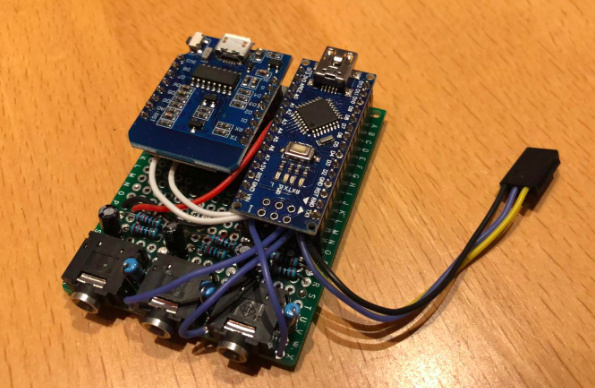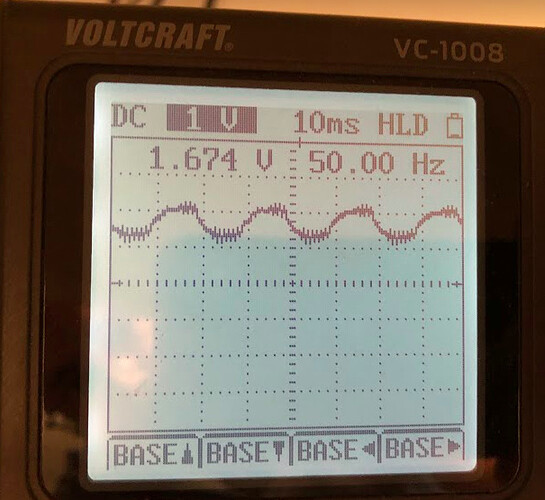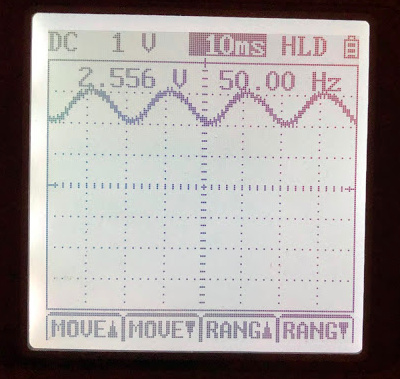I will try to put some questions in one topic as the may influence each other.
First of all I’m building this on an Arduino Pro Mini and a Wemos D1 for wifi and mqtt (but this is not of interest here).
I got everything up and running, reporting values to my mosquitto server, but was wondering why i got such high power readings.
So I went through the whole calibration test again. I got a good Fluke DMM and a high quality clamp amp meter for tests.
The setup includes 3x SCT-013-050 connected with 470k resistors and 10u cap and one ZMPT101B directly connected to the analogue pin of the arduino.
When I upload the voltage and current example I get theses reading (formated for better readability):
Voltage: 982.64 - Watt: 4234.60 - Amp1: 1.46 - Watt1: 1432.74 - realP: 738.88 - appP: 1432.74 - Factor: 0.52 -
Voltage: 628.94 - Watt: 2598.75 - Amp1: 1.18 - Watt1: 743.91 - realP: 203.49 - appP: 743.91 - Factor: 0.27 -
Voltage: 439.28 - Watt: 1873.78 - Amp1: 1.18 - Watt1: 518.27 - realP: 108.41 - appP: 518.27 - Factor: 0.21 -
Voltage: 326.63 - Watt: 1350.76 - Amp1: 1.24 - Watt1: 405.66 - realP: 44.19 - appP: 405.66 - Factor: 0.11 -
Voltage: 269.85 - Watt: 1066.26 - Amp1: 1.13 - Watt1: 303.77 - realP: 6.04 - appP: 303.77 - Factor: 0.02 -
Voltage: 245.12 - Watt: 1022.71 - Amp1: 1.13 - Watt1: 277.30 - realP: -1.18 - appP: 277.30 - Factor: -0.00 -
Voltage: 233.06 - Watt: 934.70 - Amp1: 1.16 - Watt1: 270.02 - realP: -10.81 - appP: 270.02 - Factor: -0.04 -
Voltage: 228.72 - Watt: 879.71 - Amp1: 1.18 - Watt1: 269.41 - realP: 7.65 - appP: 269.41 - Factor: 0.03 -
Voltage: 226.53 - Watt: 674.62 - Amp1: 1.09 - Watt1: 247.35 - realP: -3.38 - appP: 247.35 - Factor: -0.01 -
Voltage: 220.91 - Watt: 1834.78 - Amp1: 6.43 - Watt1: 1419.74 - realP: 1254.13 - appP: 1419.74 - Factor: 0.88 -
Voltage: 223.78 - Watt: 1851.07 - Amp1: 6.60 - Watt1: 1476.12 - realP: 1291.22 - appP: 1476.12 - Factor: 0.87 -
As you can see voltage needs about 10 runs until it’s stabilised after resetting the Arduino. Is that ok? If not what would be causing that?
I then connected a simple heater (no motor, no capacitors etc involved) to calibrate the current (turned on for the last two reading above) and calibrate power factor. No matter what I enter in “emon1.voltage(voltagePin, VOLT_CAL, PHASE_SHIFT);” it will never go above 0.87, whereas it should be almost 1.00 for the heater alone. Correct?
Btw my VOLT_CAL is at 1.300(!!!) - never seen this in any other sketch?!
The CUR_CAL is at 105 for the 50A sensors. This gives reasonable values, the higher the current is, but it’s off by 1.5A where it should be zero.
Emon Meter Delta
1.56 0.05 1.51
1.70 1.02 0.68
2.24 1.54 0.70
2.90 2.52 0.38
4.10 3.77 0.33
4.95 4.48 0.47
8.16 7.75 0.41
10.67 10.17 0.50
14.08 13.42 0.66
17.27 16.70 0.57
Any help really appreciated. Thanks!!


 . I guess to know everything just to find out that i know nothing. It’s for sure not the lack of reading as i have read all the links you gave.
. I guess to know everything just to find out that i know nothing. It’s for sure not the lack of reading as i have read all the links you gave.
